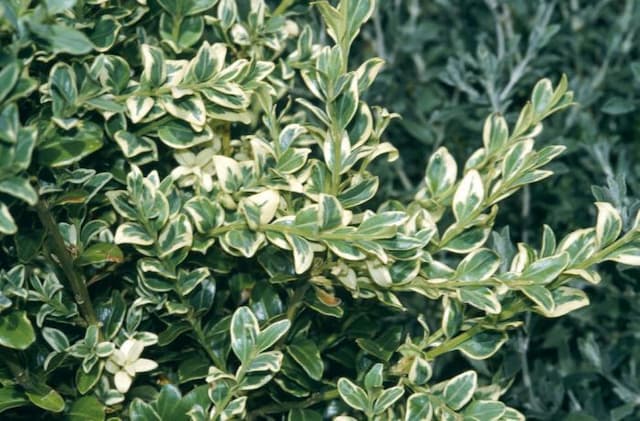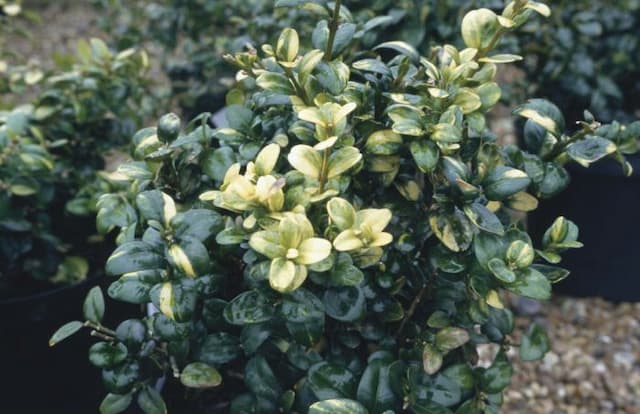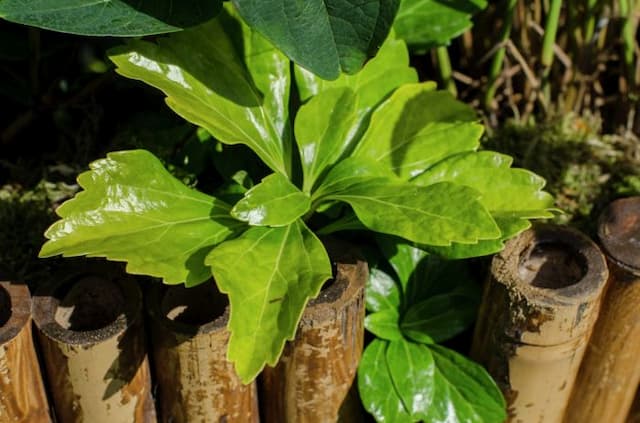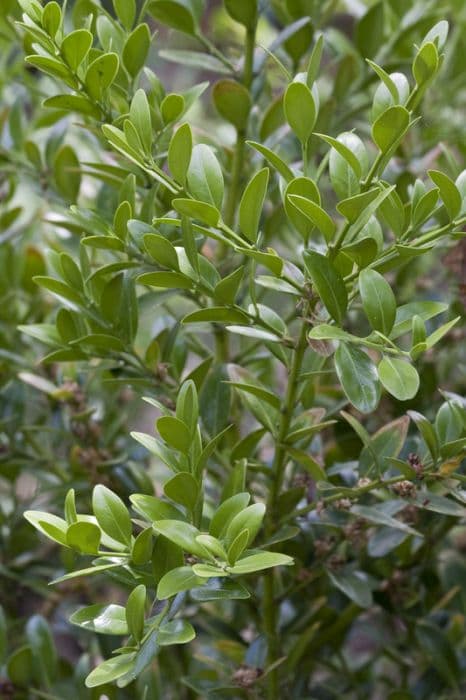Japanese Spurge Pachysandra terminalis 'Green Carpet'

ABOUT
Pachysandra, also known as Japanese spurge, is an evergreen ground cover with a lush, dense mat of green. The 'Green Carpet' variety is specifically known for its particularly rich, deep green foliage. The leaves are glossy and slightly leathery, providing a visually smooth and consistent cover when planted en masse. Each leaf is oval-shaped with a slightly toothed margin, appearing on short stems that emerge directly from the creeping, underground stems called rhizomes. The plant maintains its vibrant green color throughout the seasons. In early spring, ‘Green Carpet’ produces small, inconspicuous clusters of white flowers that nestle above the foliage, giving the plant a modest yet appealing floral display during its blooming period. Overall, the appearance of Pachysandra 'Green Carpet' is characterized by its lush, carpet-like spread of greenery, which creates a soothing and uniform ground cover suitable for shady areas in gardens and landscapes.
About this plant
 Names
NamesFamily
Buxaceae
Synonyms
Japanese Spurge, Green Carpet, Green Sheen
Common names
Pachysandra terminalis 'Green Carpet'.
 Characteristics
CharacteristicsLife cycle
Perennials
Foliage type
Evergreen
Color of leaves
Green
Flower color
White
Height
6-10 inches (15-25 cm)
Spread
18-24 inches (45-60 cm)
Plant type
Groundcover
Hardiness zones
4-9
Native area
Japan
Benefits
 General Benefits
General Benefits- Shade tolerance: Japanese Spurge performs well under tree canopies and in other low-light situations where other plants may struggle to thrive.
- Drought resistance: Once established, it can tolerate periods of dry soil, making it suitable for drought-prone areas.
- Evergreen groundcover: It retains its leaves throughout the year, providing constant ground cover and maintaining garden aesthetics in all seasons.
- Soil erosion control: Its mat-forming habit helps stabilize soil on slopes and prevents erosion.
- Low maintenance: Requires minimal care once established, with no need for regular mowing or deadheading.
- Disease resistance: It's generally resistant to common diseases that affect other garden plants, reducing the need for chemical treatments.
- Pest resistance: Japanese Spurge is rarely bothered by deer or rabbits, making it ideal for areas with wildlife pressure.
- Spreading habit: It spreads via rhizomes to fill in spaces, creating a dense carpet that suppresses weeds.
 Medical Properties
Medical PropertiesThis plant is not used for medical purposes.
 Air-purifying Qualities
Air-purifying QualitiesThis plant is not specifically known for air purifying qualities.
 Other Uses
Other Uses- Pachysandra can be used as a natural dye source, providing varying shades of greens and yellows depending on the mordants used.
- The dense foliage of Pachysandra makes it suitable for crafting fairy gardens or miniature scenic landscapes.
- Dried Pachysandra leaves can be integrated into potpourri mixtures for a subtle, woody fragrance and added texture.
- Some creative gardeners use Pachysandra as a living mulch around potted plants, reducing the need for traditional mulching materials.
- When creating model railways or dioramas, small clippings of Pachysandra can be used to mimic bushes or other greenery.
- Pachysandra can be used in floral arrangements as a long-lasting green filler to accentuate flowers.
- The plant's trailing nature and evergreen leaves can be utilized in hanging baskets for a unique, all-green display.
- Due to its hardiness, Pachysandra can be planted in pet resting areas as resilient ground cover that withstands light foot traffic.
- In crafting, Pachysandra leaves can be pressed and used for herbariums or botanical art projects due to their distinctive shape and texture.
- For sound insulation in the garden, a dense planting of Pachysandra might help to muffle ambient noises owing to its thick foliage.
Interesting Facts
 Feng Shui
Feng ShuiThe Japanese Spurge is not used in Feng Shui practice.
 Zodiac Sign Compitability
Zodiac Sign CompitabilityThe Japanese Spurge is not used in astrology practice.
 Plant Symbolism
Plant Symbolism- Unity: Pachysandra, also known as Japanese spurge, often grows in dense mats, symbolizing togetherness and collective strength.
- Perseverance: As an evergreen ground cover, Japanese spurge represents endurance and the ability to thrive in adversity, since it stays green year-round.
- Humility: The low growth habit of Japanese spurge can be seen as a symbol of modesty and humility, thriving without the need for height or dominance in a garden space.
- Protection: With its thick mat-forming characteristic, Japanese spurge can signify protection and safety, as it covers and shields the ground underneath it.
 Water
WaterJapanese Spurge, or Green Carpet, prefers consistently moist soil, so it is important to water it regularly. During the growing season, water thoroughly once a week, ensuring that the soil is moist but not waterlogged. Each watering session should provide enough water to moisten the soil to a depth of about 3 to 4 inches; this will usually be about 1 to 1.5 gallons per square yard, depending on the soil type and weather conditions. In the absence of rain, watering frequency may need to increase, especially during periods of drought or extreme heat. During the winter months, reduce watering as the plant's growth slows down.
 Light
LightJapanese Spurge thrives in partial to full shade and should be planted in a spot where it is protected from the harsh afternoon sun. The ideal location for Japanese Spurge is under the canopy of larger trees or on the north side of buildings where it will receive dappled sunlight or light shade. Too much sunlight can scorch the leaves, so be sure to monitor the lighting conditions, especially during the peak of summer.
 Temperature
TemperatureJapanese Spurge is hardy and can tolerate a range of temperatures, but it generally prefers temperate conditions. It can survive in temperatures as low as 0 degrees Fahrenheit and as high as 90 degrees Fahrenheit, but it thrives best when the temperature stays between 50 and 80 degrees Fahrenheit. These conditions encourage healthy growth without stressing this ground cover.
 Pruning
PruningPruning Japanese Spurge isn't typically necessary as it is a low-maintenance ground cover. However, to maintain a neat appearance or control its spread, you can prune or trim it back in early spring before new growth starts. This is also the best time to remove any dead or damaged foliage from the previous year. Pruning every couple of years helps rejuvenate the plants and encourages denser growth.
 Cleaning
CleaningAs needed
 Soil
SoilJapanese Spurge 'Green Carpet' thrives best in moist, well-drained soil rich in organic matter with a slightly acidic to neutral pH between 5.5 and 7. A mix of loamy soil, peat moss, and a small amount of sand or perlite can provide optimal growing conditions for healthy root systems and foliage.
 Repotting
RepottingJapanese Spurge 'Green Carpet' is a ground cover that typically does not require repotting as it prefers to spread across the ground. It is mainly planted outdoors and allowed to naturalize, so repotting is rarely, if ever, necessary.
 Humidity & Misting
Humidity & MistingJapanese Spurge 'Green Carpet' prefers average to high humidity levels but is quite adaptable and can thrive in the humidity levels typically found in most outdoor garden environments.
 Suitable locations
Suitable locationsIndoor
Ensure bright, indirect light and keep soil moist.
Outdoor
Plant in shade, rich soil, keep moist, mulch.
Hardiness zone
4-9 USDA
 Life cycle
Life cycleJapanese Spurge 'Green Carpet' begins as a seed, germinating when conditions are right—usually in moist, shaded soil. After germination, the seedling emerges and develops into a young plant through the production of basic root and shoot systems. As it matures, through vegetative reproduction, new shoots called stolons spread horizontally and root at nodes, creating a dense carpet-like ground cover. During spring, the plant produces small, inconspicuous white flowers that are not the primary ornamental feature. After the flowering period, if conditions are favorable, seeds may be produced which can be spread to new locations, but propagation is predominantly through its spreading stolons. Over time, the plant will establish a robust root system and a thick foliage mat, thriving with little maintenance when situated in suitable environments.
 Propogation
PropogationPropogation time
Spring to early summer
Propogation: For Japanese Spurge or Pachysandra terminalis 'Green Carpet', one of the most popular methods of propagation is through division. This is typically done in early spring or fall when the plant is not in active growth. To propagate by division, a gardener would carefully lift an established clump of Pachysandra from the ground, ensuring to keep a good amount of soil around the roots. The clump would then be gently divided into smaller sections, each with several growth points and a healthy root system. These individual sections can be replanted immediately into prepared soil, spaced approximately 6 to 12 inches (15 to 30 centimeters) apart to allow room for growth, and watered thoroughly to help establish the new plants. Division is particularly effective for Pachysandra as it allows for rapid establishment and spreading of the plant in garden settings.









